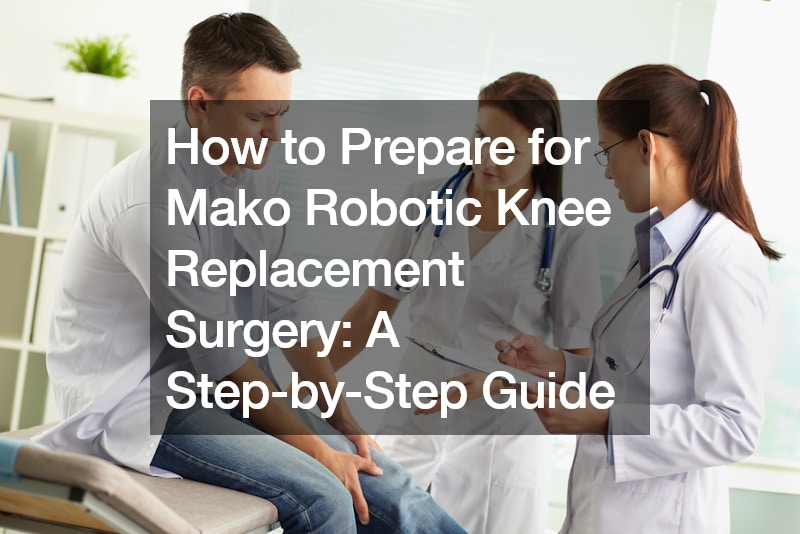

If you’re considering Mako Robotic Knee Replacement Surgery, understanding the process and how to prepare is essential for a successful outcome. This step-by-step guide will walk you through the preparation process, ensuring you’re ready for surgery and the recovery period that follows.
Step 1: Consultation and Evaluation
The journey towards Mako Robotic Knee Replacement Surgery typically begins with a consultation with an orthopedic surgeon specializing in robotic-assisted procedures. During this consultation, the surgeon will evaluate your knee condition, review your medical history, and discuss your treatment options.
If Mako Robotic Knee Replacement is deemed suitable for you, the surgeon will explain the procedure in detail, including its benefits and potential risks.
Step 2: Preoperative Preparations
Once you’ve decided to proceed with Mako Robotic Knee Replacement, your surgeon will provide specific preoperative instructions to follow. These may include:
Stopping certain medications, such as blood thinners, in the days leading up to surgery. Undergoing preoperative tests, such as blood work and imaging studies, to assess your overall health and ensure you’re a suitable candidate for surgery. Making arrangements for transportation to and from the hospital on the day of surgery, as well as arranging for assistance at home during the initial recovery period. Step 3: Optimizing Health and Fitness
Leading up to surgery, it’s essential to focus on optimizing your health and fitness levels. Engaging in activities that strengthen your muscles and improve your overall physical conditioning can help facilitate a smoother recovery process. Additionally, maintaining a nutritious diet and staying hydrated can support your body’s healing processes and enhance your overall well-being.
Latest Updates:
Recent advancements in Mako Robotic Knee Replacement Surgery have further improved surgical precision and patient outcomes. These updates include enhancements to the Mako system’s software and hardware, allowing for even more precise planning and execution of the procedure. Additionally, ongoing research and clinical studies continue to refine surgical techniques and expand the indications for Mako Robotic Knee Replacement, offering hope to patients with complex knee conditions.
Post-Surgery Care: Ensuring a Smooth Recovery Immediate Recovery Period: In the immediate hours following your Mako Robotic Knee Replacement surgery, you will be monitored closely in the recovery room. Pain management will be a priority during this time to ensure your comfort as the anesthesia wears off. Your healthcare team will provide medication as needed and monitor your vital signs.
Physical Therapy: Physical therapy plays a crucial role in your recovery journey. You will begin with gentle exercises and movements to promote circulation and prevent stiffness. Your physical therapist will guide you through a personalized rehabilitation program designed to gradually increase your mobility and strength.
Use of Assistive Devices: During the initial recovery period, you may require assistive devices such as crutches, a walker, or a cane to support your mobility. Your healthcare team will provide guidance on how to use these devices safely and effectively.
Home Care: As you transition home from the hospital or surgical center, it’s essential to create a comfortable and safe environment conducive to healing. Arrange for assistance with daily tasks such as meal preparation, housekeeping, and transportation, especially during the first few weeks of recovery.
Pain Management: Managing pain and discomfort is a key aspect of post-surgery care. Your doctor will prescribe pain medication to help alleviate any discomfort during the initial stages of recovery. It’s essential to take these medications as directed and communicate with your healthcare team if you experience any adverse effects.
Wound Care: Proper wound care is essential to prevent infection and promote healing. Keep the surgical incision clean and dry as instructed by your healthcare provider. Monitor for any signs of infection, such as increased redness, swelling, or drainage, and report any concerns promptly.
Follow-Up Appointments: Regular follow-up appointments with your surgeon are essential for monitoring your progress and addressing any concerns or complications that may arise. Be sure to attend all scheduled appointments and communicate openly with your healthcare team about your recovery experience.
Gradual Resumption of Activities: While it’s important to rest and allow your body to heal, gradually reintroducing activities is an essential part of the recovery process. Your healthcare team will provide guidance on when it’s safe to resume activities such as driving, work, and exercise.
Nutrition and Hydration: Proper nutrition and hydration are vital for supporting healing and recovery. Maintain a balanced diet rich in vitamins, minerals, and protein to fuel your body’s recovery process. Stay hydrated by drinking plenty of water throughout the day.
Emotional Support: Recovery from Mako Robotic Knee Replacement surgery can be physically and emotionally challenging. Seek support from friends, family, or a mental health professional if you’re experiencing feelings of anxiety, depression, or frustration during your recovery journey.
By following these post-surgery care guidelines and working closely with your healthcare team, you can optimize your recovery and achieve the best possible outcome following Mako Robotic Knee Replacement surgery. Remember to be patient with yourself and give your body the time it needs to heal fully.
.



